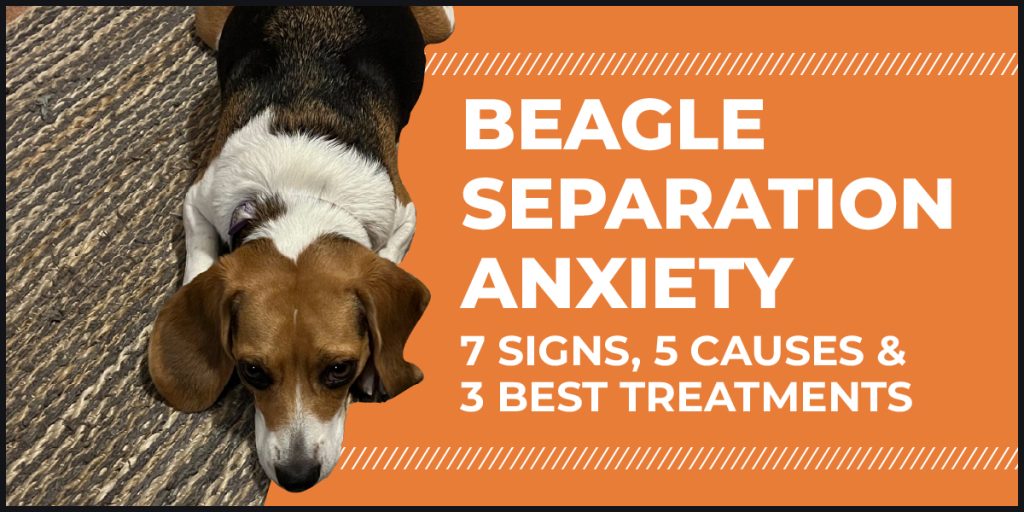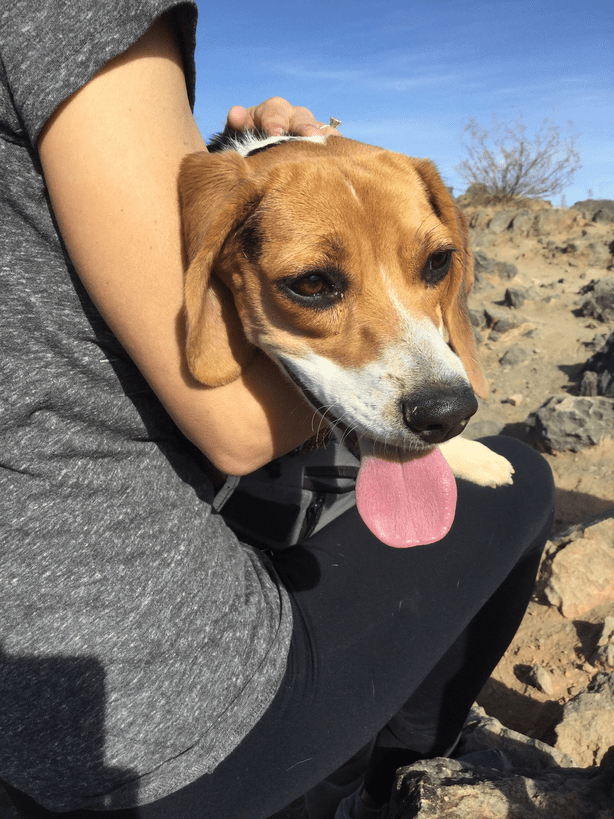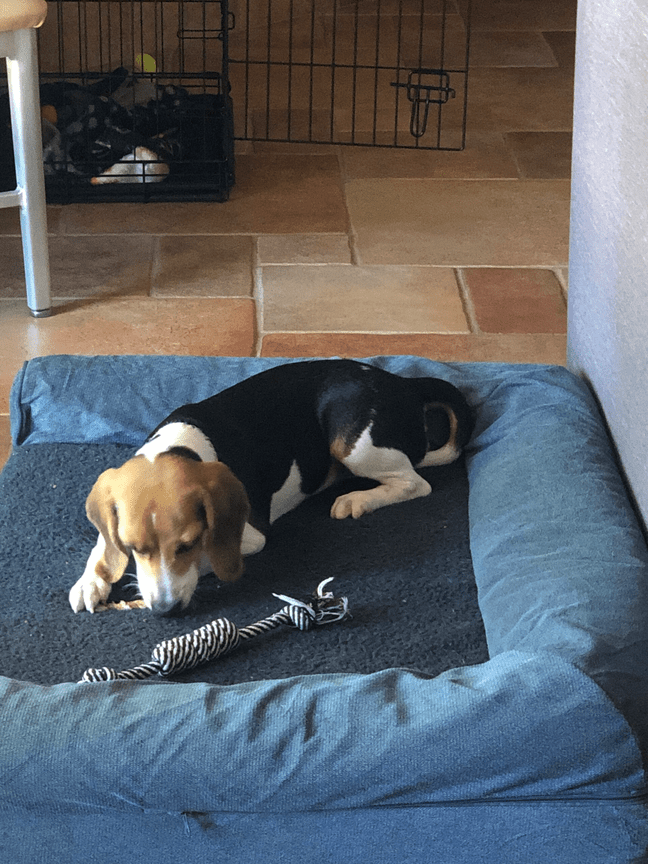Beagle owners often find themselves head over heels for their adorable, floppy-eared companions. However, these affectionate dogs can develop separation anxiety, leading to distress and emotional discomfort. If you’re a beagle owner facing such challenges, you're not alone! The good news is there are strategies and techniques you can leverage.
This comprehensive guide will help you recognize beagle separation anxiety signs, understand its causes, and implement effective strategies to enhance your bond and ease your beagle’s anxiety.
Key Takeaways
- Identify and address signs of beagle separation anxiety.
- Utilize behavior modification techniques, mental stimulation, professional assistance and environmental enrichment to reduce anxiety.
- Build a strong bond with your beagle through regular training, positive reinforcement and quality time spent together.
Find out how to train your beagle to be the well-behaved pup you desire – Read Free Report
7 Signs of Beagle Separation Anxiety
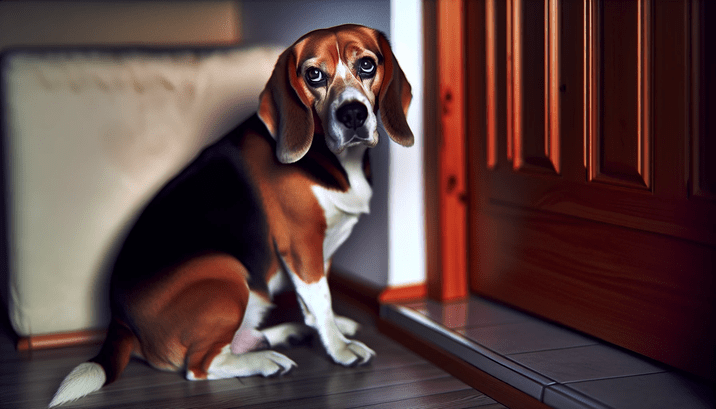
Image created with AI
Beagles may display a variety of behaviors indicating their emotional distress when left alone, a condition known as separation anxiety. These signs include:
- Destructive actions
- Excessive barking
- Obsessive pacing
- Refusal to go outdoors when the owner is not present
- Excessive drooling
- Panting
- House soiling due to incomplete house training
In more severe cases, beagles may experience these symptoms. Early recognition of these signs is crucial due to beagles’ tendency to form strong attachments to their owners and other animals, leading to a higher risk of separation anxiety.
Loud noises, such as a beagle howling or barking, can be particularly concerning for close neighbors and may result in conflicts. Additionally, Beagles with separation anxiety can become destructive, leading to damages in the house and even harm to themselves. As a Beagle owner, understanding and recognizing the signs of your dog’s anxiety is the first step in addressing the issue and helping your beloved Beagle cope.
If your Beagle is suspected of having separation anxiety, it is very important to observe their behavior and document any changes. This will help you identify patterns and triggers, allowing you to develop a training plan to ease your Beagle’s anxiety and improve their well-being. With the right approach, you can help your adorable Beagle overcome separation anxiety and feel more comfortable when left alone.
5 Causes of Beagle Separation Anxiety
Beagles are social creatures based on their origin. They have been selectively bred specifically to be a part of pack animals used for hunting game. Their innate need for companionship contributes to their propensity for developing separation anxiety. Hiring a dog sitter or a dog walker can help alleviate this issue when you’re not around.
Other factors that may cause severe separation anxiety in Beagles include:
- Lack of training
- Prolonged isolation
- Crate abuse
- Changes in schedule
- Previous punishment or abandonment experiences
Many dog owners may not be aware of these factors, which can contribute to their Beagle’s dog’s anxiety and hinder achieving dog calm, especially when interacting with other dogs.
Providing too much space for a Beagle with separation anxiety can be counterproductive, as it can emphasize their isolation and increase their distress leading to depression, or in some cases severe separation anxiety. A shift in household or changes in the family dynamic can also have adverse effects on Beagles, so it’s essential for Beagle owners to be aware of these potential triggers.
Gaining knowledge of what triggers your Beagle’s separation anxiety is a key step in formulating coping strategies. By recognizing and addressing these underlying factors, you can work towards creating a comfortable and secure environment for your Beagle, ultimately easing their anxiety and enhancing your bond. It’s important to be aware of the potential for your Beagle to develop separation anxiety and take proactive measures to prevent it.
3 Best Treatment Options for Beagle Separation Anxiety

Image created with AI
Effective treatment options for beagle’s separation anxiety include behavior modification techniques, mental stimulation, and seeking professional assistance from a veterinarian or animal behaviorist, especially if your beagle is experiencing separation anxiety.
The subsequent sections will provide a detailed discussion of these treatment options and how they can make your Beagle more relaxed when alone.
#1 – Behavior Modification Techniques
Techniques for modifying behavior, like desensitization, simulated departures, and crate training, can help Beagles adapt to solitude and lessen their anxiety. Desensitization involves systematically exposing your Beagle to the source of their anxiety, such as grabbing your car keys or opening the door, and then instantly reversing the action. Repeating this process over time can help reduce destructive behaviors like howling and destructive chewing.
Another effective technique is the use of mock departures, which can help your Beagle become accustomed to being left alone in a controlled environment. By mentally preparing your Beagle for departures and helping them feel more comfortable and confident when left alone, they can learn to cope with being alone and reduce their anxiety.
Crate training can also be an effective technique to help combat separation anxiety in Beagles. Providing ample exercise is crucial, as a tired dog is less likely to experience anxiety. By employing these behavior modification techniques, you can help your Beagle become more comfortable with being alone and reduce their anxiety levels.
#2 – Mental Stimulation and Enrichment
Providing mental stimulation through toys, puzzles, interactive games or a structured dog training program can help alleviate separation anxiety by keeping Beagles engaged and entertained while alone. Puzzle toys can assist in providing occupation and mental stimulation, helping to distract your Beagle from their anxiety.
Interactive gaming, such as fetch and tug of war, can help alleviate anxiety and enhance your Beagle’s overall contentment and well-being. Brain puzzle games, including the use of a kong toy, can act as a stress relief mechanism by engaging their focus in beneficial activities.
In summary, mental stimulation and enrichment can effectively alleviate Beagles’ separation anxiety, as these methods keep them busy and entertained during solitude.
#3 – Professional Assistance
For severe cases of separation anxiety, getting professional help from a veterinarian or animal behaviorist to formulate a suitable treatment plan is recommended for the health and safety of your Beagle. If you are unable to provide the necessary support to your Beagle regarding their anxiety and considering the additional cost, consulting a veterinarian is a prudent course of action.
Behavior modification, such as desensitization and crate training, can be a slow and gradual process that helps Beagles become more comfortable with being alone and reduces anxiety. Professional assistance can provide guidance on implementing these techniques effectively and monitor your Beagle’s progress, ensuring their well-being.
In severe cases, a vet may recommend anti-anxiety medication as a last resort. However, it is essential to exhaust all other treatment options and techniques before resorting to medication. By seeking professional assistance with beagle care tips when necessary, you can ensure your Beagle receives the proper care and support to overcome separation anxiety.
Creating a Comfortable Environment for Your Beagle
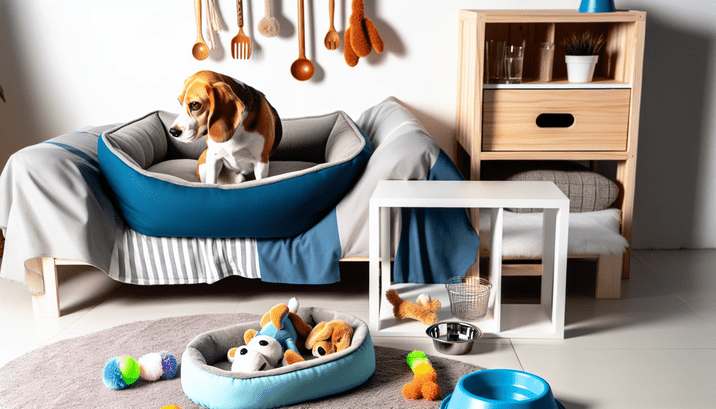
Image created with AI
Providing a cozy environment for your Beagle can help lessen their anxiety during solitude. A designated space with water, toys, and a comfortable bed should be provided. Enclosing a section of a room, such as the kitchen or living room, with a gate can create a secure space for your Beagle, helping them feel more at ease.
Deterring destruction of household items and providing background noise, such as music or white noise, can help manage separation anxiety in Beagles and improve the bond between them and their owners. The sound of cascading water from a water fountain can also draw your Beagle and promote adequate water intake.
Establishing the right environment for your Beagle is a key factor in helping them manage separation anxiety. By providing a comfortable and secure space, you can help your Beagle feel more relaxed and less anxious when left alone.
The Role of Exercise in Reducing Anxiety
Regular exercise and physical activities can help Beagles mitigate anxiety by channeling their stored energy and promoting their overall health. Various types of exercise that are beneficial for Beagles in reducing anxiety include:
- Group exercise and socialization
- Reward-based training
- Mental stimulation
- Regular physical activity
It is recommended that an adult Beagle receive at least one hour of exercise per day to maintain good mental health. This can be divided into two 30-minute walks or play sessions, ensuring your Beagle stays active and engaged. Regular exercise not only helps reduce anxiety but also contributes to a healthier and happier Beagle.
Summarily, exercise has a substantial part in lowering anxiety in Beagles. By incorporating regular exercise and physical activity into your Beagle’s routine or hiring a dog walker for a long walk, you can help them release pent-up energy, foster well-being, and reduce anxiety levels.
Want to get a free report? We're happy to help you build a strong bond with your beagle through effective training.
Building a Strong Bond with Your Beagle
Building a strong relationship with a Beagle can be achieved through the following:
- Regular training
- Positive reinforcement
- Spending quality time together
- Rewarding desirable behavior with a treat
- Forming a regular routine
- Communicating in a consistent manner
These practices can help lessen separation anxiety and strengthen the bond between you and your Beagle.
Positive reinforcement has a significant effect on a Beagle’s behavior and anxiety levels. Using reward-based training methods, such as clicker training or luring, can result in decreased levels of stress. Positive reinforcement assists in forming a positive association with desired behaviors, leading to improved behavior and a reduction in anxiety levels. It is an efficient way to cultivate a strong bond with your Beagle and improve their overall well-being.
Maintaining a regular training regimen for a Beagle with separation anxiety has several advantages. It aids them in becoming accustomed to and tranquil when left alone, diminishes their anxiety levels, and reinforces their connection with their owner. By concentrating on building a strong attachment with your Beagle, you can assist them in overcoming separation anxiety and enhancing their general life quality.
Tips for Saying Goodbye and Hello
Properly saying goodbye and hello to your Beagle, without excessive excitement or prolonged departures, can help reduce anxiety triggers and create a more positive experience when leaving and returning home. One effective method is to:
- Visualize and clearly state the desired behavior.
- Control the environment to prevent rehearsal of excited behavior.
- Utilize distractions to refocus their attention.
Refraining from being overly animated or playful during departures and arrivals can also help reduce anxiety. Maintaining a low-key atmosphere for departures and arrivals is essential, as being too exuberant or animated during these times can actually amplify anxiety. By practicing calm departures and arrivals, you can help your Beagle feel more at ease and minimize anxiety triggers.
Conclusively, bidding your Beagle goodbye and hello without over-excitement can have a significant influence on their anxiety levels. By implementing these tips, you can create a more positive experience for your Beagle when leaving and returning home, ultimately reducing anxiety triggers and improving their well-being.
Summary
Separation anxiety in Beagles can be challenging for both the Beagle and their owner. However, by recognizing the signs, understanding the causes, and implementing effective strategies, you can help your Beagle overcome separation anxiety and enhance your bond. From behavior modification techniques to mental stimulation, exercise, and building a strong bond, there are various approaches to address separation anxiety in Beagles. With patience, understanding, and consistency, you can ensure your furry friends feel more comfortable and secure, ultimately improving their well-being and happiness.
Frequently Asked Questions
Are Beagles more prone to separation anxiety than other dogs?
It is not uncommon for Beagles to have separation anxiety issues, as they are pack dogs and highly loyal to their owners. This can manifest itself in a range of anxious behaviors due to stress, rather than just being bored.
Can dogs grow out of separation anxiety?
Unfortunately, puppies won't automatically outgrow separation anxiety. Fortunately, though, it is treatable with training and extra care.
Does ignoring your dog help with separation anxiety?
Petting and soothing talk can be beneficial for most dogs with mild separation anxiety; however, ignoring them or simply saying “See you tonight” is the best approach for those with moderate to severe cases.
What are some common signs of separation anxiety in Beagles?
Common signs of separation anxiety in Beagles include unwanted behavior, excessive barking, pacing, refusal to go outside when left alone, excessive drooling, panting, and house soiling.
What are some effective behavior modification techniques for Beagles with more severe separation anxiety?
Effective behavior modification techniques for Beagles with more severe separation anxiety include desensitization, mock departures, and crate training. These techniques can help Beagles become more comfortable with being alone and reduce anxiety.
Learn how to train your beagle to be the well-behaved dog you desire –> Access our Free Report
Shop for beagle-themed products and gifts that beagle enthusiasts will love.

